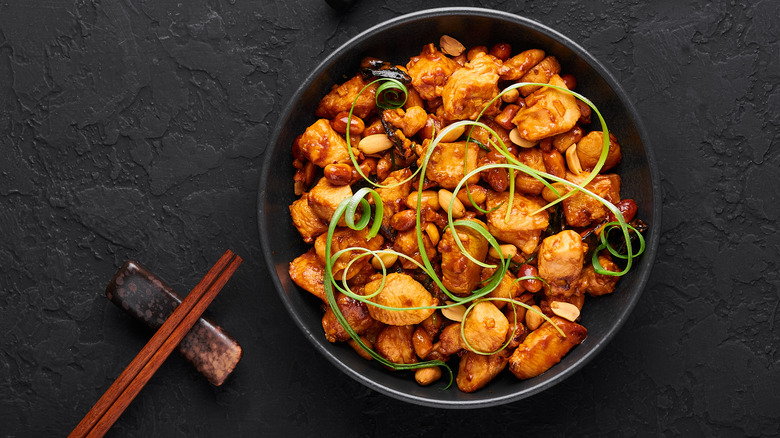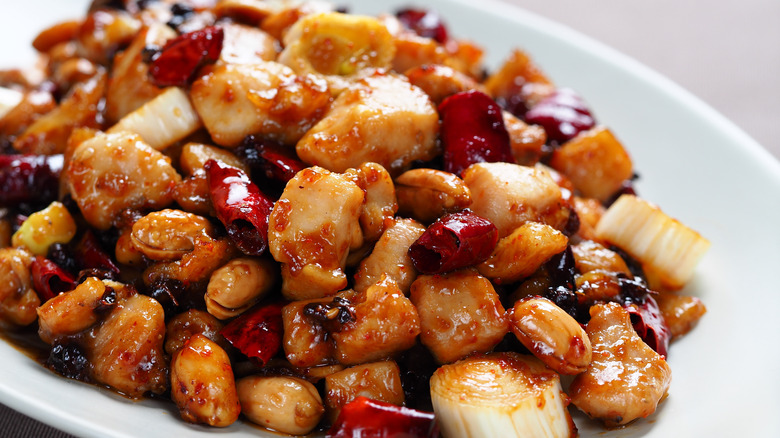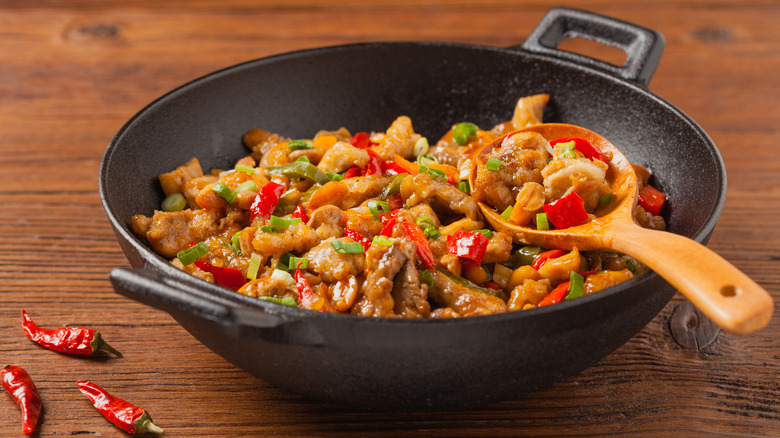The Real Person Who Inspired Kung Pao Chicken
Spicy and laced with crunchy peanuts, Kung Pao chicken (also called gong bao chicken) is an iconic inclusion in the lexicon of Chinese food.
Unfamiliar with Kung Pao chicken? One trademark of the now iconic dish is its "layering of flavors and stimulating, but not overpowering, chile heat," as noted by the Los Angeles Times. The traditional ingredients are chiles, Sichuan peppercorns, onion, ginger, garlic, peanuts, obviously chicken, and a sauce that is similar to a sweet-and-sour sauce. NPR describes the dish as so: "gong bao chicken is beautiful to look at: a glorious medley of chicken flesh, golden peanut and bright red chiles," noting that it is "pepped up with a deep chile spiciness and a trace of Sichuan pepper that will make your lips tingle pleasantly." The nuts, on the other hand, add an interesting "bite" and textural differentiation to the saucy dish.
NPR also touches on the unique hallmark of Sichuan cuisine, called "ma" or numbing, which is a ubiquitous flavor throughout many dishes hailing from that province. This "numbing" is due to the incision of Sichuan peppercorn, which yields a stubborn, numbing heat. They have even been used to cure toothaches, uniquely enough. However, they're actually not a pepper or chile, but a type of berry.
So, where does the name "Kung Pao chicken" (and the dish itself) hail from?
The potential origins of Kung Pao chicken
Kung Pao chicken is said to have been named after a "19th-century Qin Dynasty official and governor of Sichuan Province" named Ding Baozhen. The name hails from "gong bao," which means Palace Guardian. Supposedly, the progenitor of kung pao chicken was one of his favorite meals. The origins of the dish, though — and of Ding's reverence for it — are often up for debate.
NPR states that it's unclear whether Baozhen ate the dish as a child before bringing it to Sichuan, or if he enjoyed it at a local restaurant. The Los Angeles Times notes that he had a "penchant for stir-fried chicken ... [and] loved to eat it and often served it to guests." It is said that later in Ding's life, his chefs added "handfuls of dried chile and Sichuan pepper and a pleasing chord of sugar and vinegar," which is an approximation of the kung pao chicken of today.
Wu Maozhao — a chef and cookbook author — spoke with the LA Times, stating, "I think we can assume that the dish was originally based on Guizhou chicken with chiles, and acquired its name later because of Dig's fame." Guizhou chicken is in reference to a "Guizhou folk dish," which is a stew made of chicken, ciba chiles, and a sweet flour sauce.
The legacy of Ding Baozhen
According to his family, though, a young Ding Baozhen once rescued a pal who was drowning, and the family expressed their gratitude with some stir-fried chicken, considered "a great luxury at the time." After climbing political and military ranks, Ding could afford to enjoy whatever foods he liked — but supposedly still luxuriated in the comfort and familiarity of that classic dish (via the Los Angeles Times).
The first time "kung pao chicken" was published in a cookbook was in 1972, but again, it didn't contain the specific nomenclature, instead adopting a generic title. NPR notes that the dish's name (invoking Ding Baozhen) was actually considered "politically incorrect during the cultural revolution." Either way, the name was actually changed to the generic hong bao ji ding or hu la ji ding (fast-fried chicken cubes and chicken cubes with seared chiles, respectively) until the political "stigma" apparently wore off and the name took off worldwide throughout the 1980s. His name is not as recognizable as it once was, primarily due to the fact that "he was not viewed kindly by the communist government led by Mao Zedong," according to The LA Times.
Nowadays, there are myriad iterations of the classic dish. Unfortunately, many of Ding's memorials throughout his home country are no longer, but he's been memorized via his beloved dish forever.


